The Maturing of the Maah Daah Hey
We stepped out of the Dakota Cyclery shuttle truck to unload our mountain bikes just a buffalo chip or two from Teddy Roosevelt’s former ranch, the Elkhorn. Forty miles away in Medora, North Dakota, a stately ceremony was underway celebrating the 20th anniversary of the Maah Daah Hey Trail. We hoped to do our part for the occasion by laying new tread in sections of trail mostly dormant from mountain biking since the previous fall. I had a feeling that our 26th president would have approved of our adventurous spirit for tackling a rough-and-tumble landscape brimming with a unique feel of vastness and freedom unlike any other place. That unharnessed spirit must have enveloped Roosevelt as well.
Theodore Roosevelt came to the North Dakota Badlands in September 1883 to hunt some of the last remaining free-roaming bison. By the end of his 15-day hunting trip, he had entered the cattle business with the purchase of the Maltese Cross Ranch south of present-day Medora. The following year, personal tragedy struck when Roosevelt’s beloved wife and mother both died on the same day. He returned to the Badlands to improve his health and clear his mind. Roosevelt then selected another location for a second ranch, naming it the Elkhorn. He purchased the rights to the site, located 35 miles north of Medora, for $400.
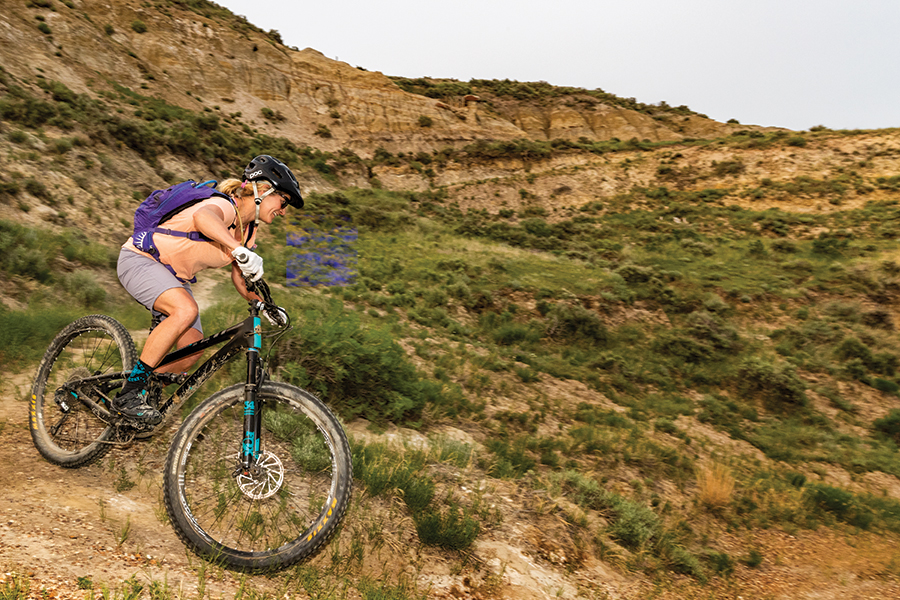
It was a time of rough virtues and rugged integrity. When he discovered one of his boats stolen, the persistent Roosevelt and two ranch hands tracked the thieves for an astonishing 300 miles before finally apprehending them and hauling them off to jail in Dickinson. Apparently, Teddy did not tolerate stealing. Roosevelt returned for good to New York soon after the brutal winter of 1886, which wiped out over half of his cattle. He was later quoted as saying, “I never would have been president if it had not been for my experiences in North Dakota.”
I’ve been putting down tire tracks in this part of the country for a long time, even before it officially became a trail in 1999. Locals Jennifer and Loren Morlock and I explored the vast coulees and grasslands by following marker flags planted in the ground, hoping we wouldn’t run over prickly pear cactus in the tall grass. Those flags eventually became solid wooden posts emblazoned with the outline of a turtle, a Mandan Indian symbol for “long, fruitful life.” That turtle shell has become the symbol of the modern-day Maah Daah Hey.
The trail has certainly matured and evolved over the past two decades. There are now 11 established campsites, and spurs along the main route such as the Buffalo Gap, which skirts around the south unit of Theodore Roosevelt National Park, and Cottonwood, which connects the lovely Bennett campground in the northern section of the route. Add to that 15 mountain bike trailheads connecting the 144 miles of trail. The southern section, often referred to as the “Deuce,” is 47 miles south of Medora. It was constructed in 2011, and its opening ceremony was held in 2014.
This year, I had enticed a group of four local riders from my hometown in Whitefish, Montana, to accompany me on an excursion. Courtney Felt, Pete Thomas, Chad Cora, and Marc O’Brien, all strong and experienced riders, had heard my tales of the Badlands for many years. I was stoked that my good friends would finally have an opportunity to make their own stories.
We began our journey by ascending the first of many climbs to come into hazy skies due to wildfires burning in northern Alberta. Amazing to think — wildfire smoke on June 1! We rode through open grasslands, descended into remote coulees or small creek crossings, and then climbed back to the next open prairie setting. Several pronghorn fawns raced by us at astonishing speeds for animals that had only been on the planet for a few days. The trail surface alternated between grasslands buff and cattle-pocked rough. The creeks were still running high as it had been a fairly wet spring. Lucky for us, we started south of any Little Missouri River crossings, which would have been running over our helmets at this point.
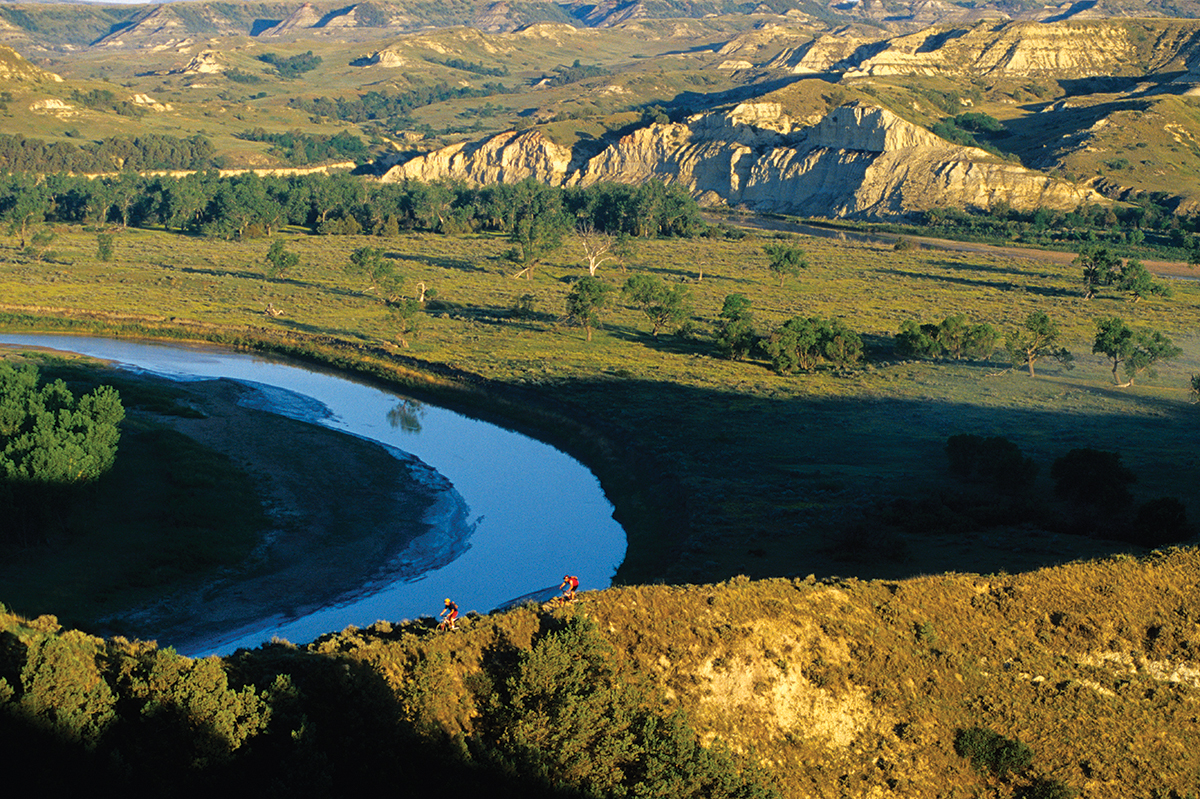
After 20 miles of riding, we ascended to a ridgeline boasting not only spectacular views in all directions but also stumps and shards of petrified wood, remnants of prehistoric sequoia trees alive during the Paleocene epoch, about 67 million and 55 million years ago. Western North Dakota was then home to a subtropical temperate forest with trees up to 12 feet in diameter and over 100 feet tall. The area then must have looked much like coastal Georgia or Mississippi, with meandering rivers, everglade-like swamps, and vast forested floodplains. To put the age of the petrified wood into perspective, after the subtropical temperate forest, the land was covered by a shallow inland sea for millions of years. The sea eventually drained away with the uplift of the Black Hills and Rocky Mountains. The more recent ice age redirected the Little Missouri River, causing erosion of the ancient sediment layers and creating the vast grasslands and Badlands that we see now.
We cruised the best part of the day, riding on the ridge, before we spotted our first campground at Wannagan Creek down below. A shining white trailer laden with our gear and supplies had been left at our campsite by Loren earlier in the day. This was a well-serviced ride! We took on a series of gnarly switchbacks that whisked us quickly to our trailer where several ice-filled coolers held enough cold beverages to quench our thirst from a full and warm day on the trail.
Our second day began innocently enough, and we departed camp on an ultra-smooth and swooping section of trail. That elation was soon wiped away when we encountered an almost unrideable two miles of “bovine obliteration.” A fence had guided a herd of cattle right onto the trail when it was wet. The result: 12- to 18-inch hoof pocks stamped into a formerly smooth trail. The decimated trail surface turned us into modern day roughriders as we got beaten and bounced. We walked, we cussed, and we swore revenge by either boycotting beef or ordering a juicy steak upon arrival back in Medora. Being the only rider on 26in. wheels, I suddenly had new-bike envy and was dreaming of a new 29in. mountain bike to help cope with the jarring experience. Having a trail system that shares land use with beef cattle, especially during a wet spring, can have bad consequences. Like Teddy, we felt we needed a bully pulpit to voice our grievances!
To be fair, according to Russ Walsh at the Little Missouri National Grasslands office in nearby Dickinson, cows often follow maintenance crews after a rain, which can be bad news. Save the Maah Daah Hey is an organization headed up by mountain bike enthusiast and true hero of the trail Nick Ybarra. Nick volunteers his own time and actually mows the entire length of the trail each summer (one side at a time, 200 miles in total) along with other maintenance chores to spruce up the trail for a series of long-distance races. The series consists of different race lengths ranging from 25 to 100 miles in one day in early August. The big race is 107 miles with over 13,000 feet of climbing. The course record was set by mountain biking legend Tinker Juarez in an astounding eight hours, 53 minutes! Suddenly I felt really slow.
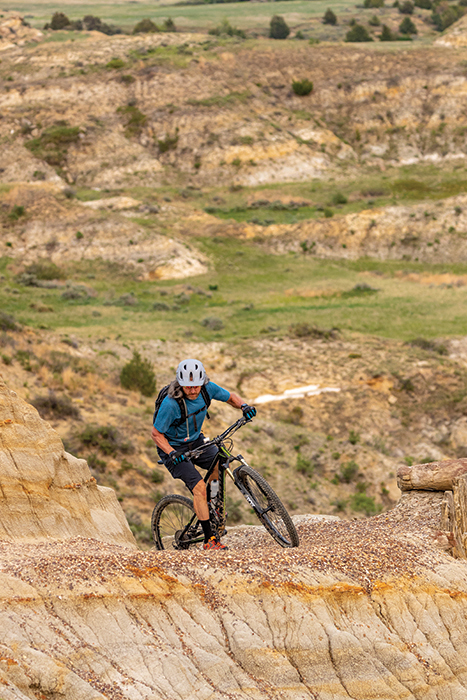
Trail conditions began to smooth out as we approached the remote entrance to Theodore Roosevelt National Park. At the juncture, we veered off the Maah Daah Hey and onto the Buffalo Gap Trail, which bypasses the national park and took us through more open country, eventually crossing under I-94 and into the town of Medora. Temperatures rose to 90°F, which felt even hotter while climbing alongside the radiating white sandstone of the Badlands. I knew something wasn’t quite right when I made a long descent all the way to the Little Missouri River when I should have stayed high up on the ridgeline. I had to push my bike most of the way back up the steep incline. At this point, I was beginning to feel the effects of sunstroke or heatstroke. I limped the last few miles into town on fumes. Fortunately, we all made it to Medora and Sully Creek campground right before a thunderstorm hit and drenched the landscape.
Quaint Medora could be branded the Mayberry of the West. Cattle ranchers and oil roughnecks belly up to the bar next to Lycra-clad mountain bikers at the Little Missouri Saloon, and horseback riders routinely saunter down the main drag. The popular nightly musical is held in an amphitheater on the outskirts of town, nestled in a most attractive Badlands setting. The town buzzes for three summer months, then it’s back to a quiet and peaceful existence for the roughly 150 full-time residents.
On Day Three, still feeling the effects of the heat, I felt I might have enough energy in me to complete a slightly shorter day, 20 miles to our next destination at Coal Creek. We passed the stainless steel post marking the original trailhead and began heading south on the newer section of trail called the Maah Daah Hey II or “Deuce.” The first mile out of Sully Creek was perhaps the most stunning piece of trail yet as we emerged onto a scenic bluff overlooking the Little Missouri River and soon the Bully Pulpit Golf Course. The newer trail south of Medora has a different feel to it than the rougher and steeper northern sections. It felt as if trail builders had learned valuable lessons as the trail flowed better, was much smoother, and just seemed more mountain bike friendly.
Another stifling, hot day did me no favors after my experience with heatstroke the day before. Climbs that I usually bust right up became dreadful, and I had to bail before I became a casualty. With only several miles to go before reaching Coal Creek campground, I got cell service and was able to track down my good friend Loren who was running a shuttle along our route. He took me back to the bike shop in Medora where I lay down on an air mattress in the air conditioning and promptly passed out. The impromptu nap revived me, and I was able to retrieve my parked car and rejoin my riding compatriots back in camp. Heatstroke is nothing to fool with. Many folks die from it each year, and I was extremely lucky not to have experienced a worse fate. Heed the warnings and don’t try to be a hero!
Our group of five relished the higher perspective of the Coal Creek campsite. We had quite the nature show as a passing thunderstorm laden with heat lightning flashed to the north near Medora. We could also see shining lights in the distance from the outdoor amphitheater in town. The crescendo was the fireworks at the show’s conclusion in sequence with a large bolt of lightning. Fortunately for us, the rain skirted our position and the trail to be ridden south tomorrow. Wet trails out here mean you are going nowhere fast.
Bentonite clay actually absorbs 16 times its dry volume when wet, puffing up the soil like popcorn. When saturated, this purplish-blue clay is one of the slickest substances known to man, bike, or beast. Gumbo, as it is affectionately referred to on the prairie, will send you flying on your backside. Worse yet, it clings to any solid surface, clogs wheels within a few revolutions, and when dry, it takes a blow torch and putty knife to blast off the cement-like substance. Bottom line: if it begins to rain hard, pedal like hell to the nearest all-weather gravel road or plan on staying put until it dries out. Mountain biking in the Badlands can be a geologist’s dream or a cyclist’s worst nightmare, depending on the weather.
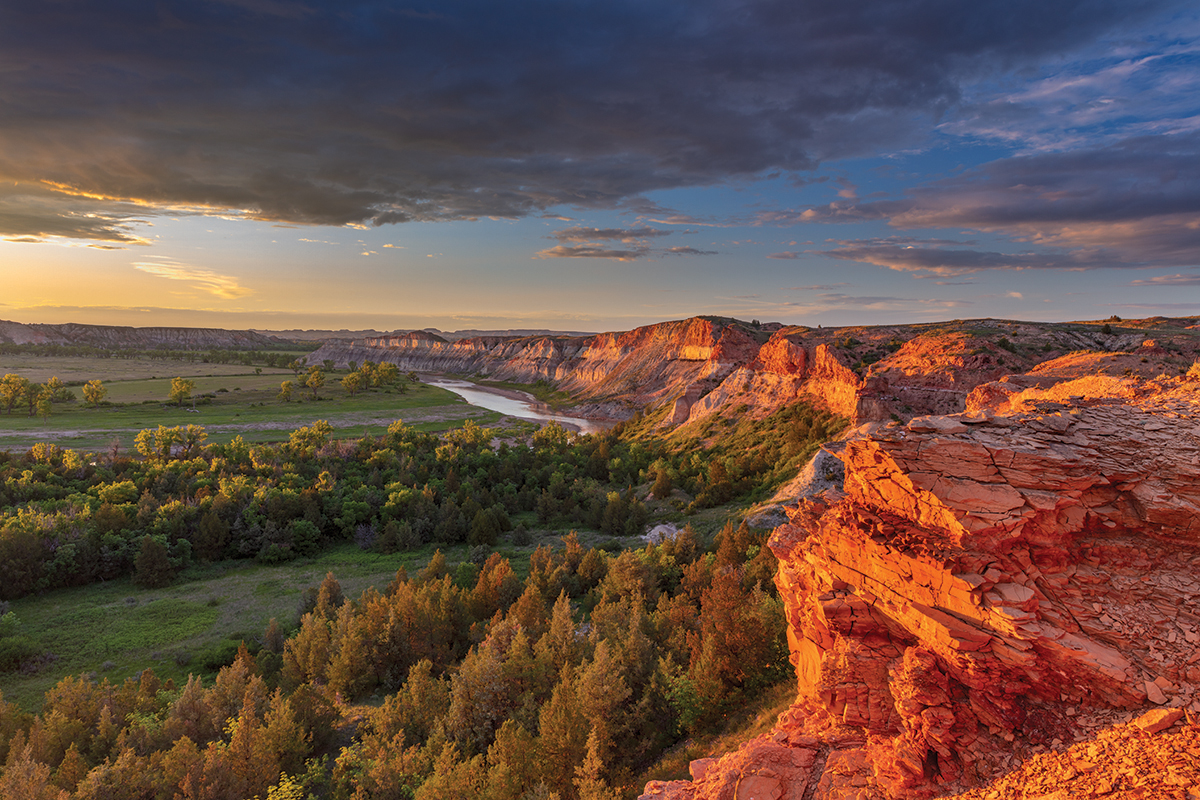
You are certainly at the mercy of Mother Nature when exposed to the raw elements of the High Plains. Loren told us of being caught, with several other riders, when a sudden thunderstorm descended upon them with fury, dumping golf-ball-sized hailstones. With no place to take shelter, Loren and his friends curled into the fetal position, got pelted, and were lucky to escape with only numerous black-and-blue bruises. Out here in Badlands Country, without any shelter and few trees, lightning- and hailstone-filled storms can be treacherous.
I spent the last day prudently being the trail photographer and meeting Courtney, Chad, Pete, and Marc along several points in the trail as they made their way south on another big day of 28 miles to the trail’s southern terminus at Burning Coal Vein campground. As I waited at several trailheads for my friends to arrive, I enjoyed watching yellow warblers and hearing nothing but songbirds in the shade of juniper trees. It was a great way to convalesce.
I spoke with longtime trail advocate and current president of the Maah Daah Hey Trail Association Curt Glasoe about the future of the trail. There are plans to extend the route another 15 to 20 miles south to the tiny burg of Amidon. Adding a gravel mix into the singletrack to harden the surface, hopefully alleviating the wet hoofprints, is also in the works. Eventually the Maah Daah Hey could be part of the exciting new Great Plains Trail. The concept would include 2,200 miles stretching from Mexico to Canada — sort of a prairie version of the Great Divide Mountain Bike Route.
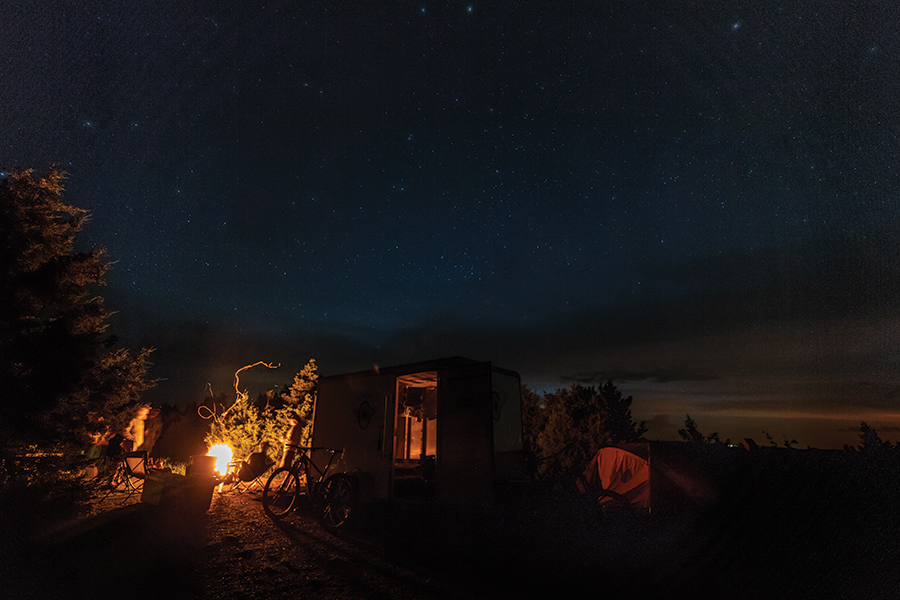
Our last evening was spent at Burning Coal Vein campground, which borders on a very unusual sight in North Dakota. It’s home to the very easternmost stand of ponderosa pine trees in the entire country. Our evening was much like the previous one when we had the entire campground to ourselves. After an exciting round of bocce, we settled in for camp grub consisting of tacos and cocktails while coyotes serenaded the coming night featuring millions of stars flickering above.
After years of hearing my stories, my friends had finally learned what being at the Maah Daah Hey was all about. Everyone agreed that the trail was harder than they had thought it would be and the Badlands setting was truly unforgettable. The camaraderie, superb camping, and the amazing scenery and solitude are addicting here. Happy 20th anniversary to a good friend!
This story originally appeared in the Dec. 2019/Jan. 2020 issue of Adventure Cyclist magazine.

